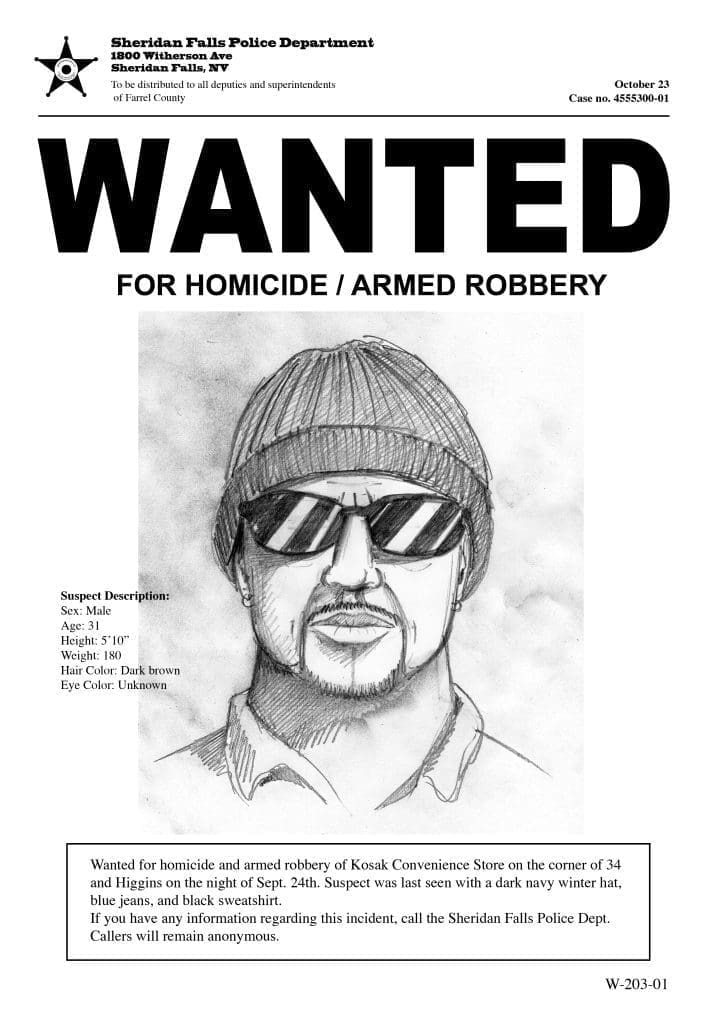Sketch Cops
An Interview with Michael Streed – Author of “SketchCops: True Stories from Those Who Draw the Line Against Crime” by the late Bill Bickel – former Managing Editor of Crime, Justice and America magazine. Originally published in 2004 and reposted with permission from Crime, Justice and America magazine
“Memory is fluid and ever-changing. It can be affected by many external sources that, in some instances, may contaminate or alter it… Despite that, sometimes eye-witness testimony is the best and only evidence available, and must be preserved as best as possible” –Michael Streed
I have to confess some prejudice here: I’ve never been a very strong believer in eyewitness identification. Some years ago, the week Gary Graham was being executed for murder after having been convicted, essentially, on the eyewitnesses identification of one elderly woman, I staged an experiment in a forensics class I was teaching: I had the students – who already knew one another – sit in pairs for a couple of days. Then I separated each set of partners and had them fill out a questionnaire describing the physical characteristics and clothing of the person they’d been sitting next to. With a couple of exceptions, nobody did a very good job.
But some recent high-profile cases have changed my opinion, at least somewhat: On June 5, 2002, 14-year-old Elizabeth Smart was abducted from her Salt Lake City home. In October, the Smarts hired a sketch artist to work with their 9-year-old daughter Mary Katherine, a witness to the abduction, and Mary Katherine described a former handyman known to the family as “Emmanuel”. I wrote a short article at the time expressing skepticism that the recollections of a 9-year-old who was half-asleep and frightened at the time, describing a man she’d seen in the dark four months earlier, would be of any value. But sure enough, the following April, just weeks after the sketch was released to the public, Brian David Mitchell — “Emmanuel” – was spotted and arrested, and Elizabeth was returned home (Mitchell is scheduled to stand trial in February of 2005; competency hearings for Wanda Barzee, his common-law wife and accomplice, are ongoing).

And a month after Elizabeth disappeared, during that terrible summer when it seemed as if children were being abducted on a regular basis, 5-year-old Samantha Runnion was taken while playing outside her California home. The only witness was a 6-year-old playmate. This case didn’t end as well: Samantha’s body was found the following day. But her alleged killer, Alejandro Avila, was arrested just three days later (his trial is scheduled to begin in January of 2005), thanks to a pair of heroes: the 6-year-old girl and police sketch artist Michael Streed, who together came up with the drawing that led somebody to recognize and tell the police about Avila.
In “SketchCops”, Streed discusses both the science and the art of identifying suspects by eyewitness identification, describes cases he’s worked on (and relevant cases worked on by other sketch artists), and talks about the latest advancements in the field. I spoke with Officer Streed shortly after reading the book:
What made you decide to become a SketchCop?
“My father was a well-known figure in local law enforcement and was known throughout the state for his expertise in traffic matters. I have always wanted to contribute more that what is normally asked for. Becoming a SketchCop served my need to give that much extra to law enforcement and victims while leaving my mark in the law enforcement community. And to not sound totally altruistic, I probably would have starved if I were only an artist.”
Do you think a defendant should be convicted of murder on eyewitness testimony alone, absent any physical evidence?
“I think there are enough safeguards built into our system that I feel comfortable with convicting people of murder based solely on eyewitness identification. I think as officers of the court we are obligated to move forward using whatever evidence we have and allow the jury to decide its weight favoring conviction or acquittal. I don’t believe however we should put someone to death based solely on eyewitness identification.”
In a recent episode of the television series Monk, the title character witnesses a crime but can only give the police artist a meticulously-detailed description of the perp’s left ear (this being television, of course, this was more than enough to catch the guy). Have you ever had to work with a similarly-partial description?
“In one instance, detailed in the book, I had only the description of the upper half of the suspect’s face to work with. He had a distinctive hairstyle that helped officers tentatively identify him. Although they weren’t able to charge him, he disappeared from the neighborhood never again to be seen peeping on unsuspecting females.”
Is it your perception that eyewitness identification by children is more readily accepted now, in the aftermath of the Samantha Runnion and Elizabeth Smart cases?
“It has helped debunk the myth that children are of little to no value as eye-witnesses. The problem comes later when you have to subject them to testifying in court and they are vulnerable to attack by defense attorneys. They can be intentionally confused and their age exploited by an aggressive defense attorney. In many cases though there is other positive ID evidence available such as DNA and fingerprints, so the child’s testimony becomes a moot issue — mostly because the defense attorney does not want the jury or court to sympathize with the child.”

I expect I’d be your worst nightmare: I’m the sort of person who can look a waitress in the eye while ordering, and 30 seconds later be unable to recognize her again. I couldn’t tell you the color of her hair or whether she was black or white, and I’ve been known to forget whether we were being served by a waiter or by a waitress. Are there special techniques you use to coax descriptions from the likes of me?
“Sometimes we recreate context such as having you re-visit the scene in your mind and have you talk your way through it again. Once we are able to isolate your view of the subject, we use verbal cues and bolter them with reference photographs of facial elements such as nose, mouth, etc. We are very careful when doing this, as we want to create the least amount of contamination of your memory while exploiting both your verbal and recognition skills.”
What exactly is “imprinting”, and could it make somebody like me more likely to provide a good description?
“‘Imprinting’ is the process where the brain records an event after the observation and filing function. The higher the trauma, the deeper an event is embedded in one’s memory. The trick is drawing the information out of someone when it so deeply embedded. Luckily, studies have shown that these memories are usually more accurate. So, if you conduct a successful interview, your chances of developing an accurate sketch rise exponentially. The short answer to your question of course is that everybody’s brain has the imprinting function. We as artists must only find the right file drawer and must use the right key to unlock it.”
Just between you and me and 200,000 readers… When you completed the sketch of Samantha Runnion’s abductor, as described by a 6-year-old, did you have any idea it would be so remarkably accurate?
“I have worked on cases like this before and obtained a remarkably accurate description and drawing from a 5 yr. old attempted kidnap victim. He described the suspect right down to his ‘jug’ ears and the cleft in his chin. Unfortunately, the DA didn’t charge him because of lack of physical evidence to corroborate his story. I totally understand and for me it was a compelling example of why we should NOT discount children as viable witness’s. So, I wasn’t surprised by the outcome in the Samantha Runnion investigation and will always applaud the witness’ courage in this case.”
Which would you say was more important for a SketchCop – artistic skills, or people skills?
“Far and away people skills. You could draw like one of the masters, but if you cannot connect with your eyewitness, the drawing becomes your own interpretation and is valueless as evidence.”
My impression of a police sketch is that it’s less a depiction of what a person actually looks like than a composite of his individual features. Is this accurate?
“Somewhat accurate. We strive for and hope the sum total of the features matches that of the suspect’s overall appearance. Sometimes though, it is a feature that stands out above all others that become the identifying piece of this facial puzzle.”

How common is it for ‘cross-racial identification” and ‘weapon focus” to be used in court to undermine eyewitness identification?
“These concepts, while very real, are often times ‘misused’ by defense experts. They can be a factor in some cases but an investigator must look carefully at the incident and pick through it “frame by frame” as if he or she is editing a movie. I once had a defense expert raise the issue of weapons focus during a trial attacking my composite sketch. What he forgot was the suspect waited in line for 20 minutes before he committed the robbery giving the eyewitness ample time to observe and catalog his facial features. As far as cross-racial ID, if the artist is careful and focuses on features only and not the race of the suspect, he can individualize the sketch and the race becomes incidental.”




















